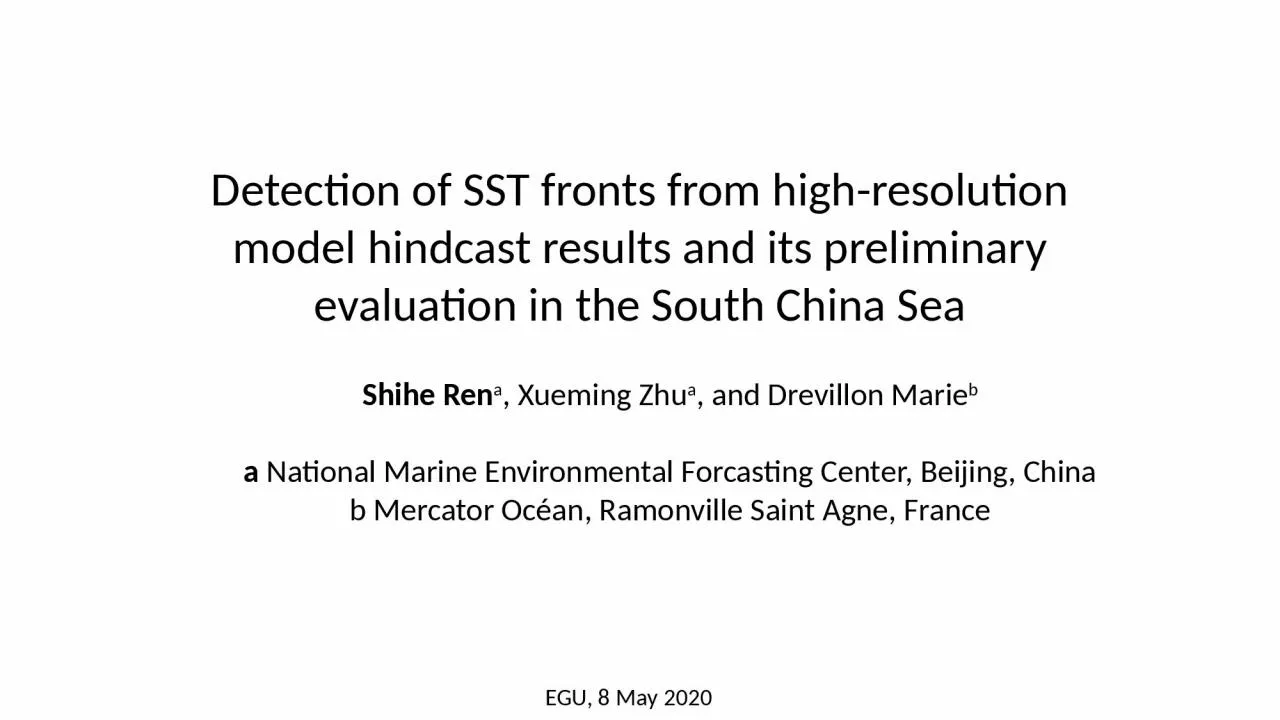

hindcast results and its preliminary evaluation in the South China Sea Shihe Ren a Xueming Zhu a and Drevillon Marie b a National Marine Environmental Forcasting Center Beijing China ID: 933324
Download Presentation The PPT/PDF document "Detection of SST fronts from high-resolu..." is the property of its rightful owner. Permission is granted to download and print the materials on this web site for personal, non-commercial use only, and to display it on your personal computer provided you do not modify the materials and that you retain all copyright notices contained in the materials. By downloading content from our website, you accept the terms of this agreement.
Slide1
Detection of SST fronts from high-resolution model hindcast results and its preliminary evaluation in the South China Sea
Shihe Rena, Xueming Zhua, and Drevillon Marieba National Marine Environmental Forcasting Center, Beijing, Chinab Mercator Océan, Ramonville Saint Agne, France
EGU, 8 May 2020
Slide2OutlineBackgroundDataFront detection algorithmResults and discussionConclusion
Slide3front detection methods gradient-based approach with Canny operator (Canny, 1986; Kostianoy et al., 2004; Breaker et al., 2005; Belkin and Oreilly 2009; Oram et al. 2008; Kirches et al. 2016; ......)histogram-based approach: single edge detection algorithm (SIED)
(Cayula and Cornillon 1992; Miller, 2004&2009; Ullman and Cornillon, 1999; Hickox et al., 2000;Nieto and Demarcq,2006; ......)other methodsstatistical approach (Ping et al. 2015; Hopkins et al. 2010; ..... )entropic approach (Shimada et al., 2005;.....)Convolutional Neural Network (Lima et al. 2017;....)
.......
Slide4Automated front detection tools for HR-model resultsDetection for HR-model data is different with satellite data.Specific pre-processing and post-processing procedure are needed to ensure balance of frontal continuity and positioning accuracy.We need highlight the quasi-stationary frontal position and
primary/strong fronts Frontal parameters and products are needed.The aim is to build mesoscale frontal forecasting system with detection, forecasting and validation.
Slide5OutlineBackgroundDataFront detection algorithmResults Conclusion
Slide6long-term daily SST(2008-2017)regional ROMS daily average hindcast in the South China Sea (1/30o)OSTIA daily SST (5km)
Mercator (1/12o) global reanalysis (PSY4V3)
Slide7OutlineBackgroundDataFront detection algorithmResults Conclusion
Slide8front detection algorithm
Frontal line Frontal Zone
detected result snapshot (frontal length greater than 100km)
Slide9frontal line detectionfront edge localization with Canny methodfront
edge following to deal with branch pixelsfront edge merging to link nearby segments
Slide10Canny edge detection stepsCalculate front gradient and direction Non-maximum suppression
determine local maxima along gradient directionchange non-maximum pixels value to zeroHysteresis thresholding Large threshold
:
less edge points, more gaps
Small threshold
:
more edge points, more false edges
E
dge linking
Strong edge
Weak edges
Weak edge removed
edges
Canny, 1986, A computational approach to edge detection, IEEE Transactions on Pattern Analysis and Machine Intelligence 8(6) , pp. 679–698
Slide11front edge followingbranch pixels still exist after edge localization (9 junctions occur in test data)necessary to extract and find which edge should be followed based on front direction and magnitude
separate branches to examine the statistics of each individual front line
frontal line extracted after edge localization
Slide12front edge following
start pixel
center pixel
non-front pixel
along-front pixel
2 pixels
1 pixels
0
pixels
Slide13front edge mergingafter merging, frontline number from 166 to 117
before merge
after merge
(a)
(b)
(d)
(c)
Slide14OutlineBackgroundDataFront detection algorithmResults Conclusion
Slide15Climatology: SST gradientOSTIA
ROMSMercator
Slide16climatology: front area occurence frequency
OSTIAROMSMercator
Slide17climatology: front line occurence frequency
OSTIAROMSMercator
Slide18OSTIA
ROMS
Mercator
Slide19front area occurence frequency
OSTIAROMSMercator
Slide20ROMS - OSTIA
Mercator - OSTIA
front area occurence frequency(bias)
Slide21climatology of front parameter
width
area
number
strength
length
seasonal varibility
Slide22summarydeveloping frontal detecting toolsfinish a stable frontal detection tools performing frontal statistical with different SST datasetsdaily, monthly, seasonal ....
frontal parameter, occurence frequency
Slide23Thank you for attention